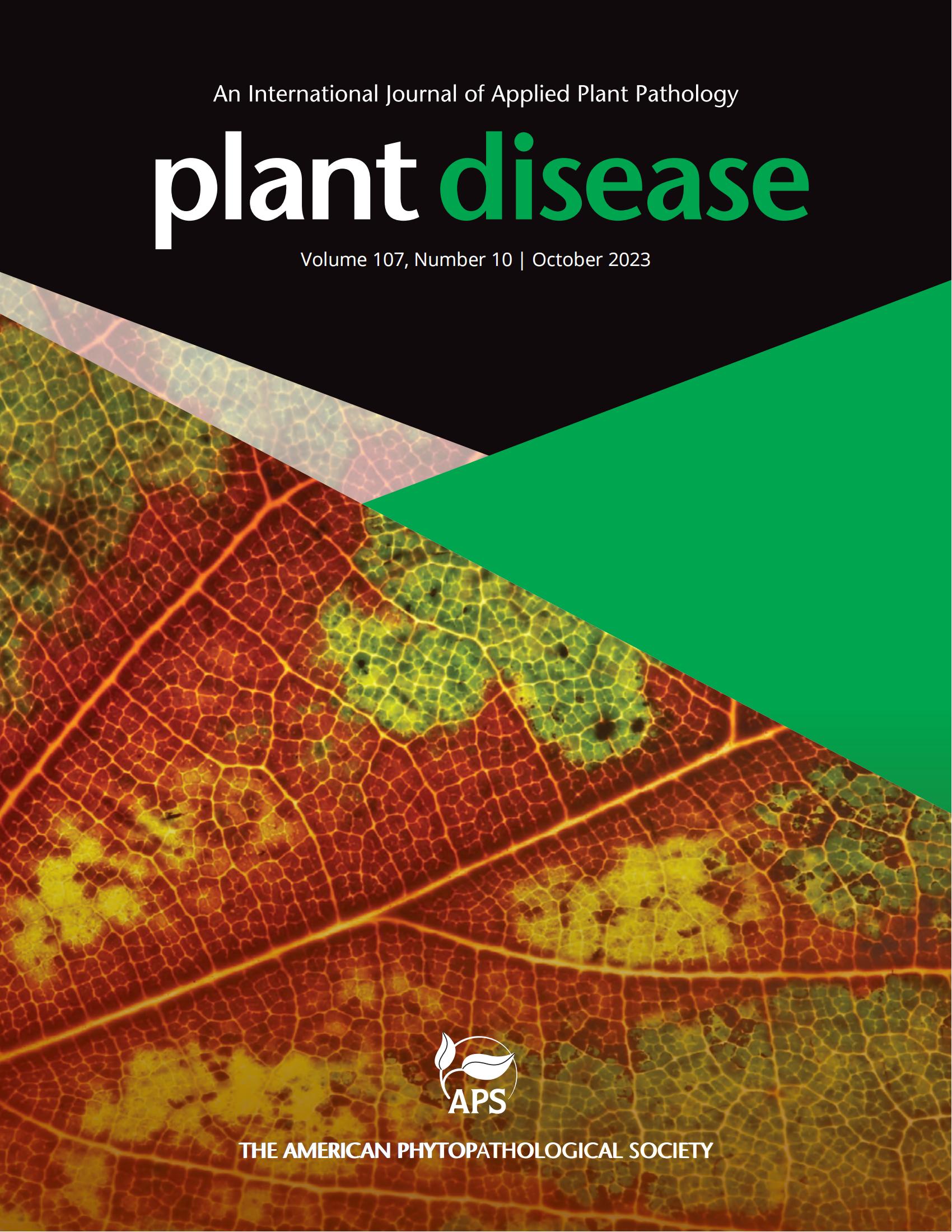斯洛文尼亚首次报告西瓜皱叶相关病毒 1 (WCLaV-1) 和 WCLaV-2。
摘要
2024年7月,从3个西瓜品种(Citrullus lanatus cvs.)的多株植株上采集了一份汇总叶片样本(D760/24)。Crimson Sweet, Asahi Miyako Hybrid F1和Top Gun)在开阔的土地上生长。0.5公顷),在斯洛文尼亚的Dombrava。纳入合并样本的植株表现出病毒样症状,如叶片花叶、萎蔫和坏死(eXtra Supplementary material Fig. S1)。该病的发病率估计为10%。DNA和RNA分别按照Mehle et al.(2013)和RNeasy Plant Mini Kit (Qiagen, Germany)的方案提取。样品经反转录(RT)-PCR检测西瓜皱叶相关病毒1 (WCLaV-1)和WCLaV-2 (Hernandez et al. 2021)呈阳性,其他病毒呈阴性(有关检测病毒和使用引物的详细信息见eXtra Table S1)。获得的WCLaV-1和WCLaV-2运动蛋白(MP)和RNA依赖性RNA聚合酶(RdRp)基因的预期大小的扩增子(eXtra Fig S2)然后进行Sanger测序(Eurofins Genomics, Germany)和BLAST分析。其中,MP (PQ570004、PQ570006)和RdRp (PQ570005、PQ570007)序列与WCLaV-1 (PP792977、PP792976)和WCLaV-2 (LC636073、LC636074)序列具有100%的同源性。Illumina高通量测序(HTS, Novogene, Germany, NovaSeq X Plus, PE150)鉴定出WCLaV-1 (PV012703-04)和WCLaV-2 (PV012705-06),以及甜瓜汞齐病毒1 (CmAV1, PV012707)和黑solanum nigrum ilarvirus 1(读取量不足,无法重建基因组片段,可能源于田间附近受感染植物的花粉污染(Rivarez et al. 2023))。HTS数据由(Pecman et al. 2022)在CLC Genomics Workbench v. 24 (Qiagen, USA)中使用管道进行分析。将一致性基因组序列与从NCBI GenBank获得的病毒最相似的参考序列进行迭代读定位重建。为了检查在斯洛文尼亚销售的西瓜种子中的WCLaVs,我们用RT-PCR检测了来自Sugar Baby、Crimstar F1和Crimson Sweet(三批)的五种种子样本。我们还测试了这些种子在3-5个真叶期生长的4个叶片样品。两种病毒均存在于所有种子和叶提取物中。然而,用两种样品(从感染的种子样品和样品D760/24中生长的植株)的汁液机械接种几种常用的指示植物,包括藜麦藜、辣椒、cleveland烟、glutinosa烟、benthamiana烟、tabacum cv。白肋草、烟叶、曼陀罗、葫芦等。Bianca di Trieste和Cucurbita maxima没有导致它们的感染。回顾性分析我们前几年的两个西瓜和84个其他葫芦样品的HTS数据显示,WCLaV-1和WCLaV-2在两个合并样本(每个样本含有相同数量的RNA)中读取:一个来自2018年,另一个来自2019年。RT-PCR证实WCLaVs仅存在于西瓜中。从2018年开始在GATC(德国,NovaSeq 6000 S2, PE 150)进行测序,从2019年开始使用Oxford Nanopore Technologies(英国,MinION Mk1B装置,SQK-PCS108, R9流动池)进行内部测序。所有的HTS读取都保存在NCBI Short reads Archive (PRJNA1202089)中。这是斯洛文尼亚和欧洲首次报告WCLaV-1和WCLaV-2病毒,由于对其流行病学了解有限,这两种病毒已被列入欧洲和地中海植物保护组织的警报清单(EPPO 2023)。需要进一步研究以确定这些病毒在欧洲的发病率,阐明其流行病学、症状关联及其对该地区西瓜生产的潜在影响。In July 2024, a pooled leaf sample (D760/24) was collected from several plants of three watermelon cultivars (Citrullus lanatus cvs. Crimson Sweet, Asahi Miyako Hybrid F1 and Top Gun) grown in an open field (approx. 0.5ha) in Dombrava, Slovenia. The plants which were included in the pooled sample showed virus-like symptoms, such as leaf mosaic, wilting and necrosis (eXtra Supplementary material Fig. S1). The disease incidence was estimated at 10%. DNA and RNA were extracted following Mehle et al. (2013) and RNeasy Plant Mini Kit (Qiagen, Germany) protocols, respectively. The sample was tested positive by reverse-transcription (RT)-PCR for watermelon crinkle leaf-associated virus 1 (WCLaV-1) and WCLaV-2 ( Hernandez et al. 2021) and negative for other viruses (details on viruses tested and primers used are available in eXtra Table S1). The obtained amplicons of expected sizes of WCLaV-1 and WCLaV-2 movement protein (MP) and RNA-dependent RNA polymerase (RdRp) genes (eXtra Fig S2) were then subjected to Sanger sequencing (Eurofins Genomics, Germany) and BLAST analysis. The MP (PQ570004, PQ570006) and the RdRp (PQ570005, PQ570007) sequences exhibited 100% identity with multiple accessions of WCLaV-1, such as PP792977 and PP792976, and WCLaV-2, such as LC636073 and LC636074. Illumina high-throughput sequencing (HTS, Novogene, Germany, NovaSeq X Plus, PE150) identified WCLaV-1 (PV012703-04) and WCLaV-2 (PV012705-06) reads, along with cucumis melo amalgavirus 1 (CmAV1, PV012707) and solanum nigrum ilarvirus 1 reads (insufficient reads to reconstruct genome segments, it may originate from pollen contamination of nearby infected plants in the field (Rivarez et al. 2023)). HTS data were analyzed in CLC Genomics Workbench v. 24 (Qiagen, USA) using the pipeline by (Pecman et al. 2022). Consensus genome sequences were reconstructed by iterative read mapping to the most similar reference sequence of the virus obtained from NCBI GenBank. To check for WCLaVs in watermelon seeds sold in Slovenia, we tested five seed samples from Sugar Baby, Crimstar F1, and Crimson Sweet (three lots) by RT-PCR. We also tested four leaf samples from plants grown from these seeds at 3-5 true leaves stage. Both viruses were found in all seed and leaf extracts. However, mechanical inoculations with the sap of two samples (plants grown from infected seed sample and sample D760/24) on several commonly used indicator plants including Chenopodium quinoa, Capsicum annuum, Nicotiana clevelandii, Nicotiana glutinosa, Nicotiana benthamiana, Nicotiana tabacum cv. White Burley, Nicotiana rustica, Datura stramonium, Cucurbita pepo cv. Bianca di Trieste, and Cucurbita maxima did not result in their infection. Retrospective analyses of our HTS data of two watermelon and 84 other cucurbits samples from previous years showed WCLaV-1 and WCLaV-2 reads in two pooled samples (containing equal amount of RNA of each sample): one from 2018 and another from 2019. RT-PCR confirmed the presence of WCLaVs only in watermelons. The pool from 2018 was sequenced at GATC (Germany, NovaSeq 6000 S2, PE 150) and from 2019 in-house using Oxford Nanopore Technologies (UK, MinION Mk1B device, SQK-PCS108, R9 flow cell). All HTS reads are deposited in the NCBI Short Reads Archive (PRJNA1202089). This is the first report of WCLaV-1 and WCLaV-2 in Slovenia and Europe, the two viruses which were included to the Alert list of the European and Mediterranean Plant Protection Organization, due to limited knowledge about their epidemiology (EPPO 2023). Further research is necessary to determine the incidence of these viruses in Europe, elucidate their epidemiology, symptoms association and their potential impact on the production of watermelons in the region.

 求助内容:
求助内容: 应助结果提醒方式:
应助结果提醒方式:


